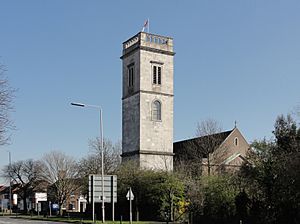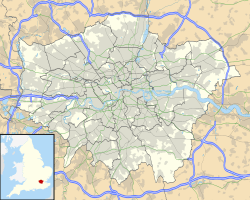All Hallows, Twickenham facts for kids
Quick facts for kids All Hallows Twickenham |
|
|---|---|

All Hallows Twickenham, as seen from the A316.
|
|
| 51°27′15″N 0°20′02″W / 51.4541674°N 0.3338385°W | |
| OS grid reference | TQ 15754 74169 |
| Location | Twickenham, London |
| Country | England |
| Denomination | Church of England |
| Churchmanship | Liberal Catholic |
| Website | www.allhallowstwick.org.uk |
| History | |
| Former name(s) | All Hallows Lombard Street St Martin's Mission Twickenham |
| Dedication | All Hallows St Martin of Tours (former) |
| Consecrated | 9 November 1940 |
| Architecture | |
| Heritage designation | Grade I |
| Designated | 2 September 1952 |
| Architect(s) | Robert Atkinson Christopher Wren |
| Style | modern |
| Groundbreaking | 11 July 1939 |
| Specifications | |
| Length | 35 m (114 ft 10 in) |
| Width | 17 m (55 ft 9 in) |
| Materials | brick, stone |
| Administration | |
| Parish | All Hallows Twickenham |
| Deanery | Hampton |
| Archdeaconry | Middlesex |
| Diocese | London (Kensington Area) |
| Province | Canterbury |
All Hallows Twickenham is a special church in Twickenham, London. It's a Grade I listed building, which means it's very important historically. This church is part of the Church of England. It includes parts of an older church called All Hallows Lombard Street. You can find it near Twickenham Stadium, right by the Chertsey Road.
The church uses many parts from All Hallows Lombard Street. That church was in the City of London and was taken down in 1937. Its stone tower, bells, stone cloister, and many inside decorations were moved here. These parts were designed by Sir Christopher Wren.
Contents
The Story of All Hallows Church
How the Church Started
All Hallows Twickenham began as a smaller church called St Martin's Mission Church. This chapel had been around for a few decades, starting in 1914. It was located on Whitton Road, next to Heatham House. The old building was taken down to make space for a beekeepers' group. This happened when the tower from Lombard Street was given to the church.
St Martin's was originally a mission of St Mary the Virgin, Twickenham. In 1933, Harold Schofield became its priest in charge. Under his guidance, the church became its own parish. He then became the vicar of the new church.
Building the New Church
The new parts of All Hallows Twickenham were designed by Robert Atkinson. He based his modern design on Christopher Wren's unfinished plans for All Hallows Lombard Street. The first stone was laid on July 11, 1939, by Arthur Winnington-Ingram, who was the Bishop of London.
The new church was officially opened on November 9, 1940, by the next Bishop, Geoffrey Fisher. During the opening, there were air-raid warnings. You could hear anti-aircraft guns in the distance. The Bishop said that churches were being destroyed by "agencies more unnatural and vile" than the Great Fire of London. The Great Fire had almost destroyed the original All Hallows Lombard Street.
What the Church Looks Like
The main part of the church is built from brick. It has a basilica shape. A narthex (entrance hall) leads through the cloister. This path takes you to the old tower on the north side. It also leads to St Martin's Chapel on the south side.
The tower was designed by Christopher Wren. It holds ten bells. Some of these bells were first used at St Dionis Backchurch. They were later moved to Lombard Street. Inside the tower, there's a huge oak gateway. This gateway was at the entrance of the old Lombard Street church after the Great Fire of London. It is decorated with carvings of skulls and crossbones.
Much of the church's carved wood looks like the work of Grinling Gibbons. It shows his style and was made around the same time as his other pieces. The large reredos (a screen behind the altar) is likely his work. It is similar to his work at St Mary Abchurch. Its size was part of Wren's original plans. The carvings are from the 17th century. The paintings on it were added during a renovation in 1870.
In the middle of the reredos, there is a carved, golden pelican. It is shown feeding its young from its own body. This is a traditional symbol of Christ. It represents how he gives himself to his followers in Communion. The main altar comes from the former local mission. The altar from Lombard Street is in the Chapel. This chapel is at the south end of the narthex.
Behind the choir stalls, which are next to the chancel, are two iron sword rests. These were for the ceremonial sword of the Lord Mayor of London. The wooden, carved chalice-shaped pulpit has a large sounding board. This pulpit also came from Lombard Street. The most famous person to preach from it was John Wesley. He preached there on December 28, 1789. It's also where he gave his first ex tempore (off-the-cuff) sermon. The pews in the church are from 1870.
The baptismal font near the west doors came from St Benet Gracechurch. Its marble base has carvings of cherubs. A tall wooden cover tops it, with a figure of Charity welcoming children. The church has an organ built by Renatus Harris in 1695. It is in the western gallery, just as Wren had planned it, but it was never put there until this church was built. Below the organ are old churchwardens' box pews. They are decorated with a lion and a unicorn, which are symbols of the royal family.
Church Activities
Services are held every Sunday. There's a service at 8:30 AM using the Book of Common Prayer. A parish communion service is at 10:00 AM. Another service at 11:30 AM is especially for families with small children. Sometimes, evening services (evensong) are held on Sundays at 6:30 PM. Daily prayers are said in the morning and evening. There is also a Eucharist service every Wednesday at 9:30 AM.
The church hall was built in the 1960s. It is used by the local community. This includes the Little Wrens Nursery School.
Car Park
The church has a car park with many spaces. It charges a fee for parking during Twickenham Rugby Stadium matches or events. This money helps pay for the church's upkeep and maintenance.
Charitable Status
The Parochial Church Council of All Hallows is a registered charity. It is listed with the Charity Commission. This means it operates for public benefit and follows charity rules.
See also


